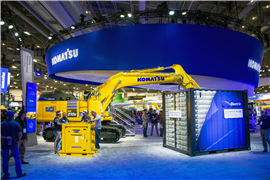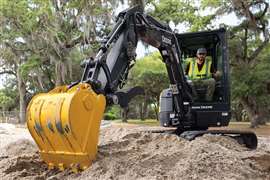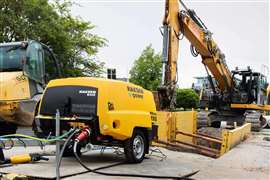5 reasons why construction jobsites are going electric
14 June 2023
Electrification of construction machinery is hardly a new concept. For years, electric equipment has been commonly seen in a variety of applications, including demolition.
 Electric powered equipment was a primary focus for many equipment manufacturers at the 2023 ConExpo exhibition in Las Vegas, US. (PHOTO: AEM)
Electric powered equipment was a primary focus for many equipment manufacturers at the 2023 ConExpo exhibition in Las Vegas, US. (PHOTO: AEM)
Now, however, electric equipment is becoming increasingly prevalent on and around jobsites.
Its potential is evident and its benefits are clear.
Its long-term place in the industry is no longer up for debate.
And, as electric vehicles continue to be more widely adopted by consumers, all that is left to do is examine – and try to accurately determine – how the construction industry should prepare for the technology to become fully mainstream in the not-too-distant future.
“If you go out about three years, there will be approximately 700 electric vehicles roadside, and that’s not even getting into construction and agriculture,” said David Knight, CEO of Terbine, a provider of technology for the seamless exchanging of IoT data between the mobility and energy sectors, who spoke on how the construction industry should prepare for the widespread adoption of electric vehicles in the not-too-distant future at this year’s ConExpo trade show.
According to David, there are five main reasons why equipment end users in the construction industry are strongly considering investing (or already have invested) in electric machinery. They are:
1. Lower operating costs
The savings on diesel costs, alone, are significant. Most OEMs cite a range of four to eight hours of runtime for “average” use on electric compact equipment, with an eight-hour overnight charge.
And while it is quick and easy to compare run times on a fully charged electric machine with a full tank on diesel units, there’s no idle on an electric machine.
Therefore, an operator can get a day or more of productive work out of it because they’re typically not running a machine for eight continuous hours a day.
2. Lower maintenance costs
Reciprocating engines possess many friction-generating parts, which fail.
The friction, and the frictional components and amount of heat generated with an engine running is really what contributes to parts being replaced and maintained.
3. Federal and state tax credits
Incentives can offer savings in the tens of thousands, or even hundreds of thousands, across a single fleet. Because they change all the time, it is important for organisations to stay up to date regarding what is available, both regionally and nationally.
4. Carbon credits and offsets
Carbon credits, also known as carbon allowances, work like permission slips for emissions. When a company buys a carbon credit, usually from the government, they gain permission to generate one ton of CO2 emissions. When one company removes a unit of carbon from the atmosphere as part of their normal business activity, they can generate a carbon offset.
Other companies can then purchase that carbon offset to reduce their own carbon footprint.
5. ESG goals
Many organisations are setting and working towards Environmental, Social and Corporate Governance (ESG) goals, a trend that is only expected to become more common with time. Without goals and corresponding policies, organisations face ESG risk, which includes loss of investors, a damaged reputation and fines for regulatory noncompliance.
There is every reason to believe the electric vehicles and electric equipment will continue to develop and improve over time, said David Knight, thus making a greater level of adoption even more likely in the very near future.
According to the Terbine CEO, the architectures of electric vehicles are going to even higher voltages. The higher the voltage, he explained, the less current is needed for a given amount of wattage.
That also means less heat. And, while voltages are very good now, they are expected to improve significantly in the coming years.
“They’re going to be really good in three to five years, and that’s going to allow for even faster and more efficient charging than ever before,” he added.
The Association of Equipment Manufacturers (AEM) is the North America-based international trade group representing off-road equipment manufacturers and suppliers with more than 1,000 companies and more than 200 product lines in the agriculture and construction-related industry sectors worldwide. The equipment manufacturing industry in the United States supports 2.8 million jobs and contributes roughly $288 billion to the economy every year.
POWER SOURCING GUIDE
The trusted reference and buyer’s guide for 83 years
The original “desktop search engine,” guiding nearly 10,000 users in more than 90 countries it is the primary reference for specifications and details on all the components that go into engine systems.
Visit Now
STAY CONNECTED




Receive the information you need when you need it through our world-leading magazines, newsletters and daily briefings.
CONNECT WITH THE TEAM













